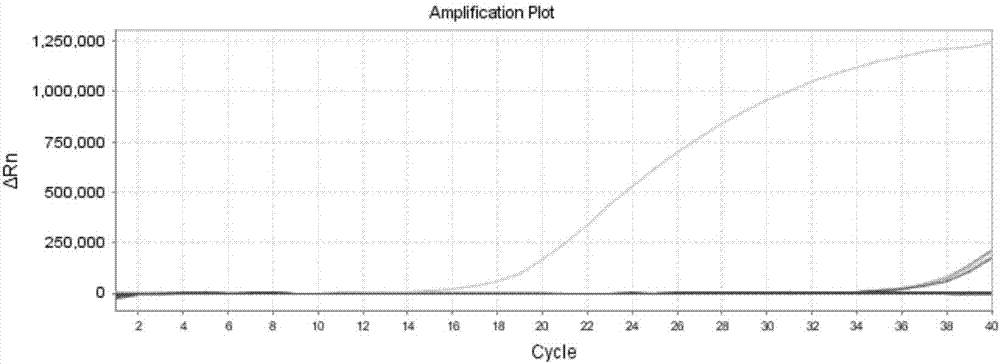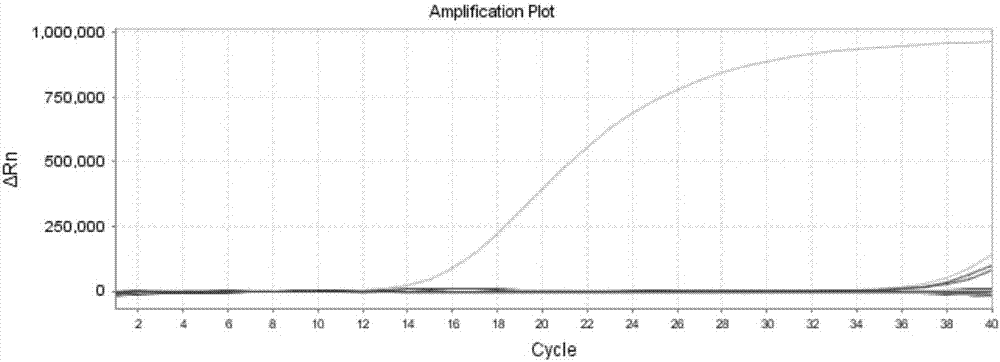Method for detecting HPV (human papillomavirus) and kit
A technology for detecting probes and nucleotide sequences, which is applied in the detection of human papillomavirus infection, molecular biology and virus detection, and can solve the problems of high cost, lack of detection methods for multiple HPV types, low efficiency, etc. question
- Summary
- Abstract
- Description
- Claims
- Application Information
AI Technical Summary
Problems solved by technology
Method used
Image
Examples
Embodiment 1
[0182] Primer pairs and probe-specific amplification and recognition of 14 HPV genotype genes
[0183] The following 14 HPV types were designed and synthesized (HPV16, HPV18, HPV31, HPV35, HPV45, HPV52, HPV56, HPV59, HPV66, HPV68, HPV33, HPV39, HPV51 or HPV58) specific primer pairs and probe sets. The standard plasmids containing artificially synthesized E6E7 gene sequence fragments corresponding to HPV types were used as templates to test the specific amplification effect of each HPV type primer pair and probe set pair corresponding to HPV types.
[0184] Table 1.14 Specific primer pairs and probe sets for HPV type genes:
[0185]
[0186]
[0187] illustrate:
[0188] HPV16 type:
[0189] Upstream primer 16E-S1: nucleotide sequence such as SEQ ID NO: 1,
[0190] Downstream primer 16E-A1: nucleotide sequence such as SEQ ID NO: 2,
[0191] Taqman fluorescent probe 16E-P1: nucleotide sequence such as SEQ ID NO: 3;
[0192] HPV18 type:
[0193] Upstream primer 18E-S...
Embodiment 2
[0269] Sensitivity test of primer pairs and probes for 14 HPV genotype genes
[0270] Test the sensitivity of the 14 HPV type-specific primer pairs and probe sets in Table 1 of Example 1 to determine the minimum detection template concentration. A 10-fold serial dilution of template DNA with a known concentration was performed, and the sensitivity of the primers and probes was determined by the least effective amplified template sample.
[0271] Use the Roche lightCycler 480II fluorescence quantitative PCR instrument to carry out amplification and fluorescence detection with the fluorescent PCR reaction condition of embodiment 1, carry out 10 times of gradient dilution with the standard plasmid of the corresponding HPV type gene fragment of known concentration and be template carry out testing. The result is as follows:
[0272] HPV16 type: 3.547×10 -8 ng / ul(4copy / ul)
[0273] HPV18 type: 3.133×10 -8 ng / ul(4copy / ul)
[0274] HPV31 type: 1.78×10 -7 ng / ul(20copy / ul)
[0...
Embodiment 3
[0288] Effectiveness and Specificity of HPV Screening Kits
[0289] Utilize the method of the present invention to carry out HPV screening to biological sample, wherein said biological sample is respectively amplified with the combination of specific primer pair and probe of following two groups of HPV type genes:
[0290] Group (1): Type 16 and Type 18 specific primer pairs and probes;
[0291] Panel (2): Type 45, Type 31, Type 39, Type 51, Type 52, Type 56, Type 58, Type 59, Type 33, Type 35, Type 66, Type 68 specific primer pairs and probes; and β - Actin specific primer pair and probe, its sequence is as follows:
[0292] Upstream primer Act517-S1: nucleotide sequence such as SEQ ID NO: 43,
[0293] Downstream primer Act517-A1: nucleotide sequence such as SEQ ID NO: 44,
[0294] Taqman fluorescent probe Act517-P1: nucleotide sequence such as SEQ ID NO:45.
[0295] Primers / Probes
Sequence (5'to3')
Upstream primer Act517-S1:
TCACCCACACTGTGCCCATCTA...
PUM
 Login to View More
Login to View More Abstract
Description
Claims
Application Information
 Login to View More
Login to View More - R&D
- Intellectual Property
- Life Sciences
- Materials
- Tech Scout
- Unparalleled Data Quality
- Higher Quality Content
- 60% Fewer Hallucinations
Browse by: Latest US Patents, China's latest patents, Technical Efficacy Thesaurus, Application Domain, Technology Topic, Popular Technical Reports.
© 2025 PatSnap. All rights reserved.Legal|Privacy policy|Modern Slavery Act Transparency Statement|Sitemap|About US| Contact US: help@patsnap.com



